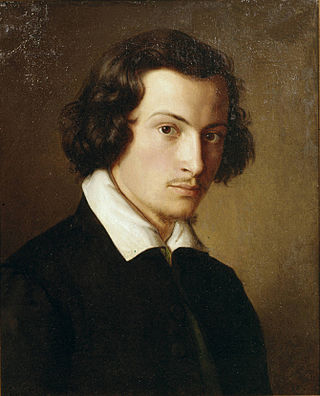
Philipp Veit was a German Romantic painter and one of the main exponents of the Nazarene movement. It is to Veit that the credit of having been the first to revive the nearly forgotten technique of fresco painting is due.

The epithet Nazarene was adopted by a group of early 19th-century German Romantic painters who aimed to revive spirituality in art. The name Nazarene came from a term of derision used against them for their affectation of a biblical manner of clothing and hair style.

The Academy of Fine Arts Vienna is a public art school in Vienna, Austria.

The Biedermeier period was an era in Central Europe between 1815 and 1848 during which the middle class grew in number and the arts appealed to common sensibilities. It began with the Congress of Vienna at the end of the Napoleonic Wars in 1815 and ended with the onset of the Revolutions of 1848. Although the term itself derives from a literary reference from the period, it is used mostly to denote the artistic styles that flourished in the fields of literature, music, the visual arts and interior design. It has influenced later styles, especially those originating in Vienna.

Friedrich Loos was an Austrian Biedermeier style painter, etcher and lithographer. He was born in Graz on 29 October 1797. He studied at the Vienna Academy with Joseph Mössmer and also went on study tours through the Austrian Alpine regions. From 1835 to 1836 he lived in Vienna, and as of 1846 he sojourned in Rome. He then moved to Kiel, where he worked as a drawing teacher at the university as of 1863 and where he also died on 9 May 1890. In his pictures he emphasized light and color in order to loosen up his painting, as well as to harmonize and unite the details.

Karl Wilhelm Hübner was a German landscape and genre painter, in the Romantic style.

Johann Peter Krafft was a German-born Austrian painter who specialized in portraits, historical works and genre scenes.

Johann Baptist von Lampi the Elder was an Austrian-Italian historical and portrait painter. He settled in the Russian Empire after the third and final partition of Poland, enticed by an extremely generous offer from the Tsar.
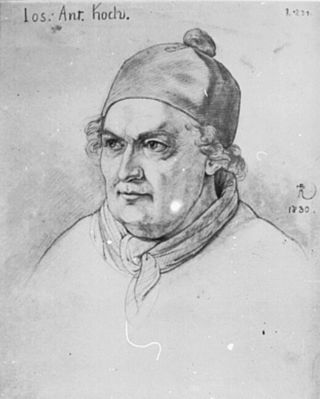
Joseph Anton Koch was an Austrian painter of Neoclassicism and later the German Romantic movement; he is perhaps the most significant neoclassical landscape painter.
Anton Altmann (1808–1871) was an Austrian landscape painter.

Franz Eybl was an Austrian painter.

Thomas Ender was an Austrian landscape painter and watercolorist.
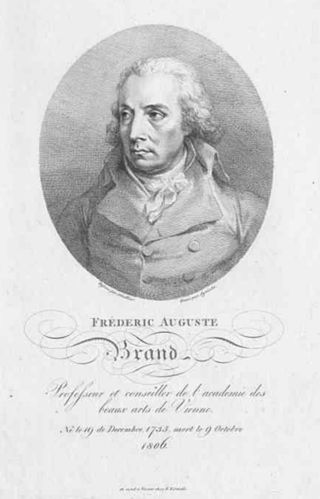
Friedrich August Brand was an Austrian painter.

Maximilian Joseph Haushofer was a German landscape painter and professor of landscape painting at the Prague Academy of Fine Arts.

Johann (Franz) Fischbach was an Austrian painter.

Ferdinand Runk, also known as Franz Ferdinand Runk, was a German-Austrian landscape painter, draftsman and etcher.
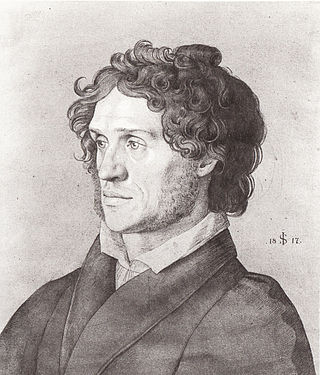
Johann Heinrich Ferdinand Olivier (1785–1841) was a German painter associated with the Nazarene movement.

Hans Larwin was a Viennese genre painter and academician.

Rudolf Swoboda was an Austrian landscape and animal painter. He is generally referred to as The Elder to distinguish him from his nephew, Rudolf, who was also an artist.
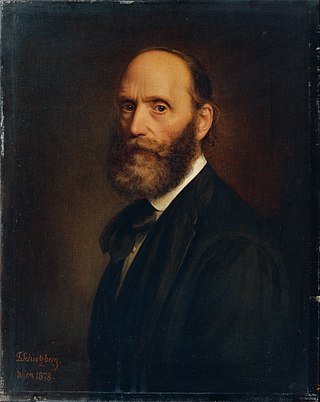
Franz Schrotzberg was an Austrian portrait painter.



















